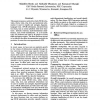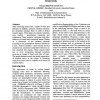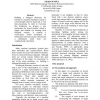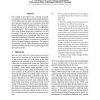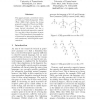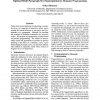ACL
2000
14 years 26 days ago
2000
This paper presents a novel statistical model for automatic identification of English baseNP. It uses two steps: the Nbest Part-Of-Speech (POS) tagging and baseNP identification g...
ACL
1998
14 years 26 days ago
1998
This paper describes novel results on the characteristics of three-party dialogues by quantitatively comparing them with those of two-party. In previous dialogue research, two-par...
ACL
1998
14 years 26 days ago
1998
This paper proposes a method by which 5WlH (who, when, where, what, why, how, and predicate) information is used to classify and navigate Japaneselanguage texts. 5WlH information,...
ACL
1998
14 years 26 days ago
1998
After extracting terms from a corpus of titles and s in English, syntactic variation relations are identified amongst them in order to detect research topics. Three types of synta...
ACL
2000
14 years 26 days ago
2000
Building a bilingual dictionary for transfer in a machine translation system is conventionally done by hand and is very time-consuming. In order to overcome this bottleneck, we pr...
ACL
1998
14 years 26 days ago
1998
ACL
1998
14 years 26 days ago
1998
The multiplicative fragment of linear logic has found a number of applications in computational linguistics: in the "glue language" approach to LFG semantics, and in the...
ACL
2000
14 years 26 days ago
2000
This paper presents a restricted version of Set-Local Multi-Component TAGs Weir, 1988 which retains the strong generative capacity of Tree-Local MultiComponent TAG i.e. produces t...
ACL
1998
14 years 26 days ago
1998
We present a connectionist architecture and demonstrate that it can learn syntactic parsing from a corpus of parsed text. The architecture can represent syntactic constituents, an...
ACL
1998
14 years 26 days ago
1998
There exist several methods of calculating a similarity curve, or a sequence of similarity values, representing the lexical cohesion of successive text constituents, e.g., paragra...

